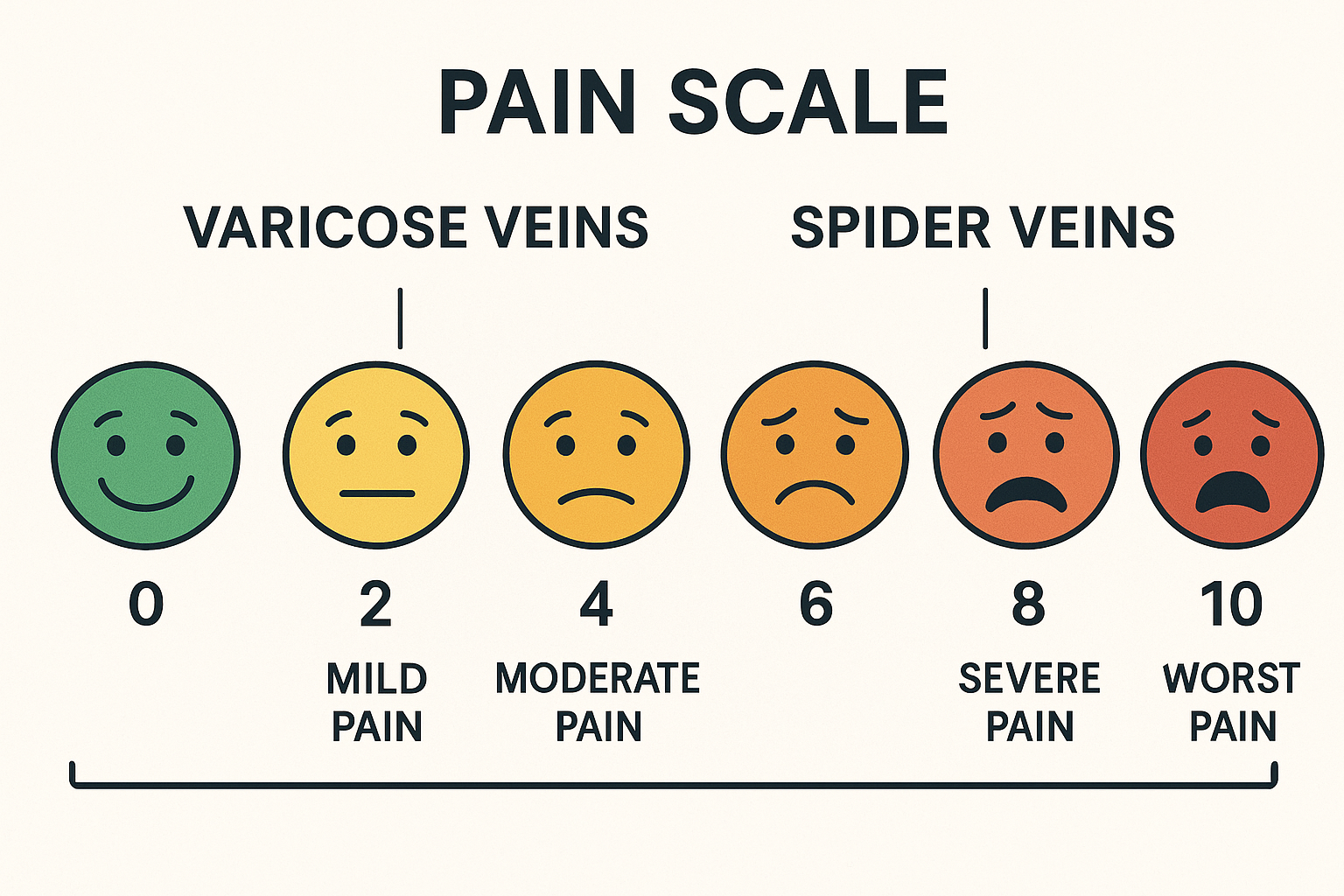Why Do Spider Veins Hurt More Than Varicose Veins?

Most people think of spider veins as a cosmetic problem—those small, web-like clusters of red, blue, or purple veins that often appear on the legs or face. In contrast, varicose veins—the larger, bulging, rope-like veins—are often seen as the ones that cause more discomfort.
But here’s a surprising fact: some patients experience more pain from spider veins than from varicose veins.
As a vein specialist at Sheen Vein (Aesthetics and Functional Medicine), I’ve seen this many times, and patients are often shocked to learn there’s a medical reason why those tiny veins can cause significant discomfort.
Let’s explore why.
Understanding Spider Veins vs. Varicose Veins
- Spider veins (telangiectasias) are very small veins—just under the surface of the skin—measuring less than 1 millimeter in diameter. They often appear in clusters and may spread like a spider’s web.
- Varicose veins are larger (over 3 millimeters), twisted veins that bulge above the skin’s surface due to faulty vein valves and poor circulation.
While varicose veins are more visible and dramatic in appearance, the size of the vein does not always correlate with the level of discomfort.
Why Spider Veins Can Hurt More
1. Location Near Nerve Endings
Spider veins sit just beneath the surface of the skin, right where there are many sensory nerve endings. Even a small amount of pressure or inflammation in these veins can irritate surrounding nerves, leading to burning, stinging, or aching sensations.
In contrast, varicose veins are located deeper in the leg tissue, where nerve density is lower, so pain signals may not be as intense or localized.
2. Inflammation and Irritation
When spider veins dilate and become engorged, they can cause localized inflammation in the surrounding tissue. This inflammation can trigger hypersensitivity, making even light touch or pressure uncomfortable.
Varicose veins can also cause inflammation, but because they’re deeper, it’s often felt as a dull ache or heaviness rather than sharp or burning pain.
3. Blood Flow Dynamics
Both spider and varicose veins are signs of venous insufficiency—a condition where faulty vein valves allow blood to pool rather than flow efficiently back to the heart.
In spider veins, blood pooling is highly concentrated in a small area. This localized congestion can increase pressure in surrounding capillaries and nerve-rich tissues, making discomfort more noticeable.
4. Triggers That Worsen Symptoms
Spider vein pain can be triggered or worsened by:
- Standing or sitting for long periods
- Heat (hot showers, summer weather)
- Hormonal changes (pregnancy, menopause)
- Tight clothing that restricts circulation
Because spider veins are close to the skin’s surface, these triggers can have a more immediate and noticeable effect.
Symptoms of Painful Spider Veins
Not all spider veins are painful, but when they are, patients may describe:
- Burning or stinging sensations
- Localized aching
- Tenderness to touch
- Throbbing, especially after standing
- Itchiness in the affected area
It’s important to note that pain is a sign of underlying circulatory stress—and it should not be ignored.
When to See a Vein Specialist
If you have spider veins that are painful, warm to the touch, or associated with swelling, it’s time for an evaluation. Painful spider veins may indicate:
- Early venous insufficiency
- Inflammation in the vein wall (phlebitis)
- Increased venous pressure from deeper, untreated vein issues
At Sheen Vein (Aesthetics and Functional Medicine), we use duplex ultrasound to look beneath the surface and identify whether there’s an underlying cause for your spider vein pain.
Treatment Options for Painful Spider Veins
1. Sclerotherapy
The gold-standard treatment for spider veins. We inject a tiny amount of medical solution into the vein, causing it to collapse and fade over time. This relieves pressure and irritation, reducing pain.
2. Laser Vein Therapy
For very small or delicate spider veins—especially on the face—laser therapy can seal them off without needles, using targeted light energy.
3. Addressing Underlying Vein Disease
If ultrasound shows deeper venous reflux, we may recommend endovenous laser therapy (EVLT) or other minimally invasive vein procedures to address the root problem before treating the surface veins.
4. Lifestyle Support
- Wearing compression stockings to improve circulation
- Avoiding prolonged standing or sitting
- Elevating legs after activity
- Staying active to promote blood flow
Bottom Line
Spider veins may look small and harmless, but for some patients, they can cause significant discomfort—sometimes more than large varicose veins. The pain comes from their location near nerve endings, localized inflammation, and concentrated blood pooling in sensitive tissues.
The good news is, you don’t have to live with the discomfort. Modern vein treatments are quick, effective, and require little to no downtime.
📍 Serving St. Louis, Sunset Hills, Kirkwood, Webster Groves, and surrounding Missouri communities
📞 Call 314-842-1441 or request your consultation online to find out what’s causing your vein discomfort and how we can help you feel and look better.
Internal Links for SEO: